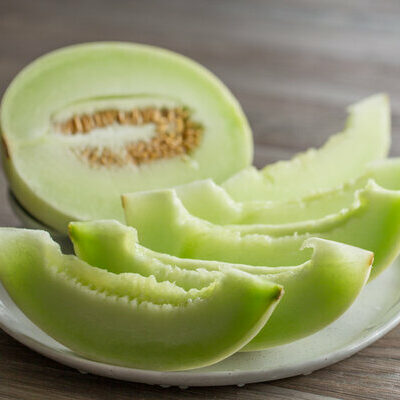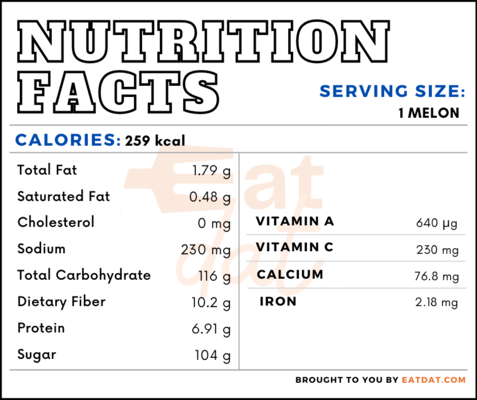
Honeydew Melon
What is a Honeydew Melon?
Honeydew is a type of melon that belongs to the Cucumis melo family, the same family as the cantaloupe. Honeydew melon has an inedible light green and yellow rind and an edible pale green flesh. The fruit is formed around a bunch of seeds, which can also be shelled and consumed.
- A fully ripe fruit is juicy and has a very sweet taste.
- These melons are great for consuming ripe, but they can also be used in salads, desserts, baked goods and drinks like aguas frescas or smoothies.
The top 10 most popular melons in the world are:
- Watermelon
- Cantaloupe
- Honeydew Melon
- Winter Melon
- Casaba Melon
- Persian Melon
- Galia Melon
- Snap Melon
- Canary Melon
- Bitter Melon
Origin of honeydew melons
Many melons have their origin in Central America but honeydew appears to have West African roots. Archaeological evidence points towards its cultivation around 2400 BC in Egypt, at the earliest. However, honeydew melon would not reach Europe until the 15th century, where it had to be grown in glasshouses due to colder climates. Spanish conquistadores are credited with transporting the seeds of this fruit to the Americas where it would later flourish.
Nutrition
Nutritional profile for honeydew melon (1 melon):

Honeydew melon is rich in potassium, sodium, vitamin C, folate, carotene, vitamin A, and lutein + zeaxanthin. Additionally, it contains calcium, magnesium, phosphorus, choline, and vitamin K in decent amounts. Also, honeydew melons increase the bioavailability of β-carotene. They contain large amounts of various phenolic compounds and antioxidants.
Commercial production
Honeydew requires a dry climate and sandy soils to thrive. The vines that produce these fruits can typically grow 3 to 4 melons. However, these vines must be pollinated by bees to grow proper fruits. Once ripe, fruits are harvested by maturity rather than size with ripe melons exhibiting a creamy, yellow skin. Harvested fruits are commonly cooled with forced air and may be treated to ripen the melons more uniformly while being stored before sale.
China and Turkey are the main producers of honeydew. The USA, Honduras, Costa Rica, Mexico, and Guatemala are also producers.
Honeydew melon recipes
This melon may be eaten raw as well as in baked dishes, salads, and desserts. Also, it works well pickled or cooked into soups. Here are a few recipes:
- Smoothie
- Sorbet
- Cucumber Honeydew Salad
- Honeydew Margarita
- Milkshake
- Honeydew Melon Juice
- Honeydew Loaves
- A Whole Melon Cake
- Melon Tiramisu
- Watermelon Cake
- Melon and Apple Berry Crumble
- Honeydew Sago Dessert
- Melon Soup
- Green Gazpacho
FDA regulations
The FDA describes all fresh fruits, including honeydew melons, as raw agricultural commodities and strictly regulates all aspects of their growing, harvesting, packing, and storage. The USDA provides import restrictions and quality standards for this fruit.
References
Fleshman, Matthew K et al. “Carotene and novel apocarotenoid concentrations in orange-fleshed Cucumis melo melons: determinations of β-carotene bioaccessibility and bioavailability.” Journal of agricultural and food chemistry vol. 59,9 (2011): 4448-54. doi:10.1021/jf200416a, https://www.ncbi.nlm.nih.gov/pmc/articles/PMC3544477/
Honeydew Melon, Blue Book Services, https://www.producebluebook.com/know-your-commodity/honeydew-melon/
